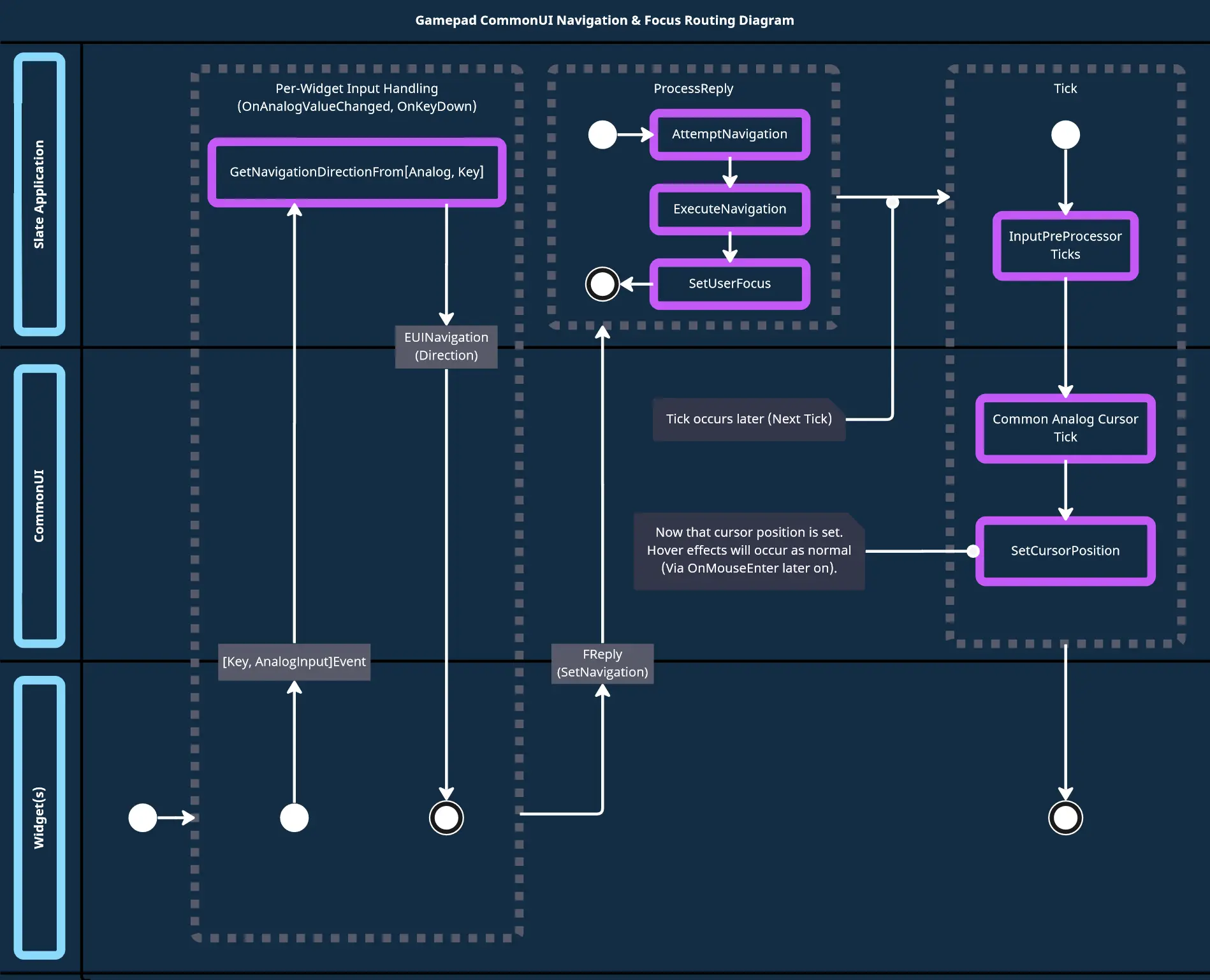WARNING
加入了commonUI后,总有一些意想不到的问题,研究了一下。
总结一下可能遇到的问题:
- Input Mode 和 CommonUI 冲突
- 导航键(键盘的Tab,手柄的DPad) 被CommonUI占用
- 确认键(FaceButton Bottom) 被CommonUI占用
TL;DR 太长不看
commonUI 有两个“Focus”, 一个是Widget的Focus,另一个是Input Mode 的Focus。
如果当前屏幕里有 focus的widget,那么导航键 就有可能被 CommonUI 吃掉,尤其是 Input Mode是All的情况。取消勾选 Focusable 即可:
或者,在 OnFocusReceived里面,手动调用 Set Focus to Game Viewport
CommonUI 没有自动激活相应的 Input Mode,勾选Supports Activation Focus 即可。
确认键(FaceButton Bottom) 被CommonUI占用:可以通过 C++ 重写父类判断的方法来解决
一些概念
让AI总结了一些
在 Unreal Engine 的 Slate 和 UMG 系统中,"Focus Path" 是一个重要的概念,用于管理用户界面中焦点的导航和传递。焦点路径主要用于键盘和游戏手柄等输入设备的焦点管理。
Focus Path 的定义
Focus Path 是指一系列的 Widget,通过这些 Widget 焦点可以顺畅地导航。焦点路径用于管理用户界面中焦点的传递,特别是键盘和游戏手柄等输入设备的焦点管理。
注释分析
路由事件
/**
* Route an event along a focus path (as opposed to PointerPath)
*
* Focus paths are used focus devices.(e.g. Keyboard or Game Pads)
* Focus paths change when the user navigates focus (e.g. Tab or
* Shift Tab, clicks on a focusable widget, or navigation with keyboard/game pad.)
*/这段注释解释了焦点路径与指针路径(PointerPath)的区别。焦点路径专门用于焦点设备(如键盘和游戏手柄)。当用户通过 Tab、Shift Tab、点击一个可以获取焦点的 Widget 或使用键盘/游戏手柄进行导航时,焦点路径会发生变化。
- PointerPath:指的是与鼠标指针相关的路径。
- Focus Path:指的是与键盘或游戏手柄等焦点设备相关的路径。
焦点路径中的事件
/**
* If focus is gained on on this widget or on a child widget and this widget is added
* to the focus path, and wasn't previously part of it, this event is called.
*
* @param InFocusEvent FocusEvent
*/
UFUNCTION(BlueprintImplementableEvent, BlueprintCosmetic, Category="Input")
UMG_API void OnAddedToFocusPath(FFocusEvent InFocusEvent);这段注释和代码解释了当一个 Widget 或其子 Widget 获得焦点,并且该 Widget 被添加到焦点路径中时会触发的事件。具体来说,如果一个 Widget 之前不在焦点路径中,但由于焦点的转移(例如用户按下 Tab 键)而被添加到焦点路径中,就会触发 OnAddedToFocusPath 事件。
- InFocusEvent:这是一个
FFocusEvent对象,包含了与焦点变化相关的信息。
RouteAlongFocusPath 方法
RouteAlongFocusPath 方法通常用于将事件沿着焦点路径进行传递。它确保焦点路径中的每个 Widget 都能正确地接收到和处理事件。例如,当用户按下 Tab 键时,焦点会从一个 Widget 转移到下一个 Widget,RouteAlongFocusPath 方法会确保这个过程顺利进行。
FocusPath 总结
- Focus Path 是一系列可以顺畅导航的 Widget,用于管理键盘和游戏手柄等输入设备的焦点。
- RouteAlongFocusPath 方法用于将事件沿着焦点路径进行传递,确保每个 Widget 都能正确处理事件。
- OnAddedToFocusPath 事件在 Widget 被添加到焦点路径时触发,用于处理焦点变化。
FReply 类是 Unreal Engine 5 中用于处理 Slate 事件响应的一个核心类。它的主要功能是通知系统某个事件是如何被处理的,以及指示系统在处理事件后需要执行的操作。以下是对这个类的分析:
FReply
所以输入事件的操作,都是通过构造一个FReply对象,并对其设置响应的值,一层一层地传递处理。
FReply 类是一个用于在 Slate 系统中处理和响应事件的工具类。它提供了丰富的 API,用于指示系统如何处理鼠标事件、焦点管理、导航、拖拽操作等。通过返回 FReply 对象,开发者可以灵活地控制事件处理流程,增强用户交互体验。
事件处理状态:
Handled()和Unhandled()静态方法用于创建一个表示事件处理状态的FReply对象。Handled()表示事件已被处理,Unhandled()表示事件未被处理。
鼠标事件处理:
注意,这些都是设置相应的值,最终处理是在Tick里。
CaptureMouse(TSharedRef<SWidget> InMouseCaptor):请求系统将鼠标事件捕获到指定的 Widget。UseHighPrecisionMouseMovement(TSharedRef<SWidget> InMouseCaptor):请求启用高精度鼠标移动。SetMousePos(const FIntPoint& NewMousePos):请求将鼠标光标移动到指定位置。LockMouseToWidget(TSharedRef<SWidget> InWidget):请求将鼠标锁定在指定 Widget 的范围内。ReleaseMouseLock():请求释放鼠标锁定。ReleaseMouseCapture():请求释放鼠标捕获。
焦点管理:
SetUserFocus(TSharedRef<SWidget> GiveMeFocus, EFocusCause ReasonFocusIsChanging, bool bInAllUsers):请求将用户焦点设置到指定的 Widget。ClearUserFocus(bool bInAllUsers)和ClearUserFocus(EFocusCause ReasonFocusIsChanging, bool bInAllUsers):请求清除用户焦点。CancelFocusRequest():取消先前的焦点请求。
导航:
SetNavigation(EUINavigation InNavigationType, const ENavigationGenesis InNavigationGenesis, const ENavigationSource InNavigationSource):请求系统尝试进行指定类型的导航。SetNavigation(TSharedRef<SWidget> InNavigationDestination, const ENavigationGenesis InNavigationGenesis, const ENavigationSource InNavigationSource):请求导航到指定的 Widget。
拖拽操作:
DetectDrag(const TSharedRef<SWidget>& DetectDragInMe, FKey MouseButton):请求系统检测指定 Widget 的拖拽操作。BeginDragDrop(TSharedRef<FDragDropOperation> InDragDropContent):开始一个拖拽操作。EndDragDrop():结束当前的拖拽操作。
其他操作:
PreventThrottling():请求在鼠标按下时不进行 UI 响应的节流。
FCommonAnalogCursor
函数 IsGameViewportInFocusPathWithoutCapture
/**
* A ridiculous function name, but we have this exact question in a few places.
* We don't care about input while our owning player's game viewport isn't involved in the focus path,
* but we also want to hold off doing anything while that game viewport has full capture.
* So we need that "relevant, but not exclusive" sweet spot.
*/
bool IsGameViewportInFocusPathWithoutCapture() const;WARNING
官方说这个函数的名字很搞笑。。
这段注释解释了函数 IsGameViewportInFocusPathWithoutCapture 的作用:
- 不关心输入:当拥有玩家的
GameViewport不在焦点路径中时,我们不关心输入。 - 暂停操作:当
GameViewport完全捕获输入时(即具有全捕获),我们也不做任何操作。 - 理想状态:我们寻求的是一个“相关但不独占”(“relevant, but not exclusive”)的状态,即
GameViewport在焦点路径中,但没有完全捕获输入。
方法 Tick
void FCommonAnalogCursor::Tick(const float DeltaTime, FSlateApplication& SlateApp, TSharedRef<ICursor> Cursor)
{
// Refreshing visibility per tick to address multiplayer p2 cursor visibility getting stuck
RefreshCursorVisibility();
// Don't bother trying to do anything while the game viewport has capture
if (IsUsingGamepad() && IsGameViewportInFocusPathWithoutCapture())
{
// 省略其他代码
}在 Tick 方法中,我们可以看到对 IsGameViewportInFocusPathWithoutCapture 的调用:
- 刷新光标可见性:每一帧刷新光标的可见性,以解决多玩家第二个玩家光标可见性卡住的问题。
- 判断条件:如果正在使用游戏手柄,并且
GameViewport在焦点路径中但没有捕获光标,则执行后续代码。
大致了解FReply,在看官方这个图,就好理解很多。 
官方说明
When navigation input occurs, the input is handled by the default SWidget::OnKeyDown or SWidget::OnAnalogValueChanged methods. However, these default methods do not directly change widget focus. Instead, the following occurs:
The navigation method uses either FSlateApplication::GetNavigationDirectionFromKey or FSlateApplication::GetNavigationDirectionFromAnalog to translate the input into a navigation direction. It takes the Navigation Config for the widget into account when it runs this translation.
The navigation direction is captured and included in the FReply::Handled reply, which is sent through FReply::SetNavigation.
WARNING
FReply can carry a lot of contextual information. For more see the information on FReply in the Input Routing section below.
Slate starts processing the FReply using FSlateApplication::ProcessReply, which causes navigation to occur. If a navigation event is loosely defined by direction, then _FSlateApplication::AttemptNavigation _attempts to find the correct widget to navigate to.
If possible, FSlateApplication::ExecuteNavigation navigates to the destination widget.
If the destination widget is valid, FSlateApplication::SetUserFocus is called on that widget. This happens whether the destination widget was specified directly, or found beforehand.
After the Slate focus navigation occurs, FCommonAnalogCursor::Tick automatically moves and centers the synthetic cursor onto the focused widget during the next tick.
This makes it possible to use hover effects when you use a gamepad.
